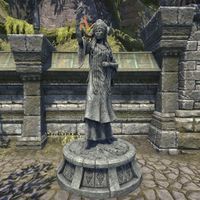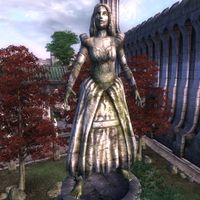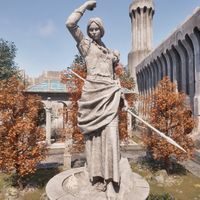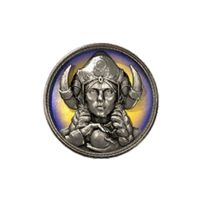Lore:Alessia
| Queen Alessia | |||
|---|---|---|---|
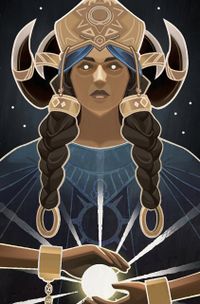 Queen Alessia Queen Alessia
|
|||
| Race | Nede | Gender | Female |
| Born | First Era Cyrod |
||
| Died | 1E 266 White-Gold Tower |
||
| Resided in | Sardavar Leed Sancre Tor White-Gold Tower |
||
| Reign | 1E 243- 1E 266 |
||
| Next Ruler | Belharza the Man-Bull | ||
Alessia, also known as Queen Alessia, Saint Alessia,[2] the Lady of Heaven,[1] Queen-ut-Cyrod,[1] Queen of Mortals,[3] Slave Queen of Cyrodiil,[4][5] Mother of the Empire,[6] Queen of Stars,[6] and El-Estia,[7] was the first Empress of Cyrodiil and the founder of the Alessian Empire, the first of three Cyrodilic empires. She led the Alessian Slave Rebellion against the Ayleids in the third century of the First Era, freeing the Nedes of Cyrod from slavery and founding the Alessian Empire. As the first Empress of Cyrodiil, she established a new religion, a fusion of the Nordic and Aldmeri pantheons known as the Eight Divines. On her deathbed in 1E 266,[8] she was canonized by Akatosh,[3] and her soul placed in the central stone of the Amulet of Kings, thus forging Akatosh's covenant with men to protect Tamriel from the forces of Oblivion[9] and starting the Oversoul of emperors.[10] She has also been stated to have achieved apotheosis in death,[8][11] and was described as becoming wife to Shor and Auri-el, in addition to her marriage with Morihaus.[7] Among worshippers of Pelinal Whitestrake, Alessia is the patron saint of humanity.[12] The Empress is associated with The Thief Constellation.[13]
Alessia is not her birth name, but rather a corruption of a title, Al-Esh ("High Highness"), that was given to her by her followers. Another title bestowed on her was Paravant ("The First"). From corruptions of these two titles come countless other names by which she is known to various peoples, including Perrif, Paraval, Pevesh, Perrethu, Paravania, and Aleshut.[1] The Alessian Order was so-called because she purportedly appeared to the prophet Marukh in a vision and bestowed her teachings upon him, for which she was known by the Order as the "Enlightened One".[14][15] The Ayleids derogatorily called her the "cattle-queen" during the Rebellion.[16]
History[edit]
Biography[edit]
Alessia was born to an unknown tribe and grew up in Sardavar Leed, also known as Sard.[1] In Cyrod, the heart of the Ayleid Empire, all races of men were slaves of the Ayleids. She prayed to Akatosh and the Aedra for liberation from the Daedra armies of the Ayleids.[9]
Alessia's prayers were answered when she was granted three visions by Akatosh at Sancre Tor.[18] Another legend states she received a vision from Akatosh in one of the old Ayleid shrines beneath the White-Gold Tower, after which her followers tore it down and built the Dragonfire Cathedral.[19] Regardless, once she was free she began an open revolt against her slavemasters.[20] Working alongside her demigod lover Morihaus, Alessia raised an army. In 1E 242, Pelinal Whitestrake wandered into her encampment covered in Ayleid blood; her second champion had arrived.[17] With momentum growing stronger, human forces took control of Cyrodiil east of the Niben River.
Forging alliances with Skyrim and rebel Ayleid lords,[21] Alessian forces encircled the capital of the White-Gold Tower. With coalition forces hesitant to attack, Pelinal Whitestrake stormed the tower alone and slew the Sorcerer-King Umaril the Unfeathered. Eventually Morihaus followed with the rest of the army and captured the citadel. The Ayleids were gradually pushed out of Cyrodiil; many became refugees, fleeing to Valenwood.[22]
With the capture of the White-Gold Tower in 1E 243,[23] Alessia declared herself the first Empress of the new Cyrodilic empire, and established Sancre Tor as her holy city. According to legend, Akatosh made a covenant with Alessia and gifted her the Amulet of Kings as a token of this pledge and proof of her claim.[3][20][24] His second gift was the Sublime Brazier, a powerful relic built in the Dragonfire Cathedral that was instrumental in upholding the covenant through the lighting of the Dragonfires.[19] Empress Alessia inherited the Laureled Diadem from the Ayleid Empire, though instead of destroying it, she fashioned it with Twin Red Diamonds and wore it as the Star-Made Diamond Diadem.[25]
One of the first challenges facing the new empire was the establishment of a religion acceptable both to the people of Cyrodiil, accustomed to an Aldmeri-derived pantheon, and to her Nordic allies, who were opposed to any elven deities.[5] As a compromise, she established the Eight Divines, which incorporated elements of both Aldmeri and Nordic religions.[5] As of the Fourth Era, this religion remained the dominant faith of Cyrodiil, although, with the addition of Talos, it became more commonly known as the Nine Divines. At the end of the Great War, the Empire signed the White-Gold Concordat, which outlawed worship of Talos throughout the Empire, reverting the official Imperial pantheon to Alessia's original pantheon.[26]
At some point, Alessia bore a son named Belharza.[27][28][25] Belharza was thought to be fathered by Morihaus and is considered by some to be the first Minotaur.[27][28][29] Their union created the entire Minotaur race.[27][30]
Pelinal was supposedly present at Alessia's death bed despite his own death years earlier. He described another half that along with himself would take her up and reveal their true faces, "which eat one another in amnesia each Age", to her.[11][31] Upon Alessia's death in 1E 266, she was said to have been buried in the catacombs beneath Sancre Tor. This later developed into a tradition for Reman Cyrodiil and the Reman Dynasty, who were also buried under the city; however, a competing tradition asserts Alessia was instead buried on the site of the Temple of the One in the Imperial City.[20] On her death, Belharza succeeded her as the second Emperor of Cyrodiil.[27][32]
Legacy[edit]
Following the rise of the Alessian Order, depictions of Saint Alessia were posthumously outlawed, leaving very few contemporary depictions of Alessia herself.[33] The earliest known depictions were believed to have been created nearly a millennium after her reign had ended, and are presumed to have been commissioned as gifts for Empress Hestra by the newly admitted province of High Rock.[33] Fort Alessia, situated just east of Sardavar Leed, was presumably named after her.[34]
Some sources claim that the prophet Marukh's teachings, which questioned the validity of Elven rule, were inspired by him speaking to the "Enlightened One", Saint Alessia, in a vision. These sentiments led to an increasingly abstract and unknowable depiction of a Single God.[15] They heavily influenced the Alessian Order and their secret sect, the Marukhati Selective. The priesthood of Marukh saw no difference between spiritual and political matters. This was the religion of the Alessian Empire, and it taught that to resist the Emperor was to resist the Gods.[35]
The Remanada, a mythical text describing the life of Reman Cyrodiil, claims that King Hrol was visited by the spirit of Saint Alessia, who "bore in her left hand the dragonfire of the aka-tosh and in her right hand the jewels of the covenant and on her breast a wound that spilt void onto her mangled feet", and was considered to be an incarnation of the land itself. From the union of Hrol and Alessia at Sancre Tor, an act which caused Hrol's death, it is said that Reman Cyrodiil was conceived, though skeptics suspect that this heritage was a fabrication intended to legitimize his rule.[7][36][37]
The mysterious Prophet of Anvil had knowledge of the Amulet's oversoul and claimed to be able to sense its presence and hear it speak.[36] The Prophet claimed he could hear Alessia weep for fallen Cyrodiil, and ask for her issue to walk in her steps and for blood akin to hers to rekindle the dragonpact.
Gallery[edit]
Imperial statue of Alessia (Oblivion)
Notes[edit]
- Nine Coruscations, a religious text of Ayleid origins, mentions the "Numinous Paravant", a being with "unbound hands", and thus the potential to achieve the goal of the Daedric Prince Ithelia to reach Numancia, breaking the shackles of fate thus giving everyone their own desired history, a state the eventual realization of which is somehow tied to the limitations of linear time imposed by Ada-Mantia and Convention. Ithelia's Ayleid worshippers seemed to believe they could somehow cause the Numinous Paravant to appear by commiting violence against Man. The Numinous Paravant might have been Alessia, who rebelled against the Ayleids, and one of whose titles is "Paravant".[38][39]
See Also[edit]
- More information on Alessia can also be found in these books.
- Remanada — Fragmented, mythical recounting of the conception of Reman and the return of the Chim-el Adabal with the people of Tamriel
- The Legendary Sancre Tor by Matera Chapel — An attempt to chronicle the rise and fall of Sancre Tor
- The Song of Pelinal — The life of Pelinal Whitestrake, assembled from various old fragmentary texts
- The Sublime Brazier by Augusta Purusius, Associate Historian, Imperial Academy of Records and Histories — The legend of a mythical cauldron used to kindle the Dragonfires
- Trials of St. Alessia — Excerpt from a greater work detailing the creation of the Amulet of Kings
- Of the Dragonfires (Fragment) — A portion of Saint Alessia's conversation with the "Divine Voice"
References[edit]
- ^ a b c d e The Adabal-a — Morihaus
- ^ A Dance in Fire, Chapter 1 — Waughin Jarth
- ^ a b c Trials of St. Alessia
- ^ 2920, Sun's Height — Carlovac Townway
- ^ a b c Shezarr and the Divines — Faustillus Junius
- ^ a b The Prophet's dialogue in Oblivion: Knights of the Nine
- ^ a b c Remanada
- ^ a b Cleansing of the Fane
- ^ a b The Amulet of Kings — Wenengrus Monhona
- ^ Where Were You When the Dragon Broke? — Various
- ^ a b The Song of Pelinal, v 8
- ^ Philius Dormeir's dialogue in ESO
- ^ High Astrologer Caecilus Bursio Answers Your Questions — High Astrologer Caecilus Bursio
- ^ The Illusion of Death
- ^ a b Pocket Guide to the Empire, 1st Edition: Cyrodiil — Imperial Geographical Society, 2E 864
- ^ Umaril is Undone — Thadoril
- ^ a b The Song of Pelinal, v 2
- ^ Chancellor Abnur Tharn Answers Your Questions — Chancellor Abnur Tharn
- ^ a b Drake of Blades' dialogue in ESO: Imperial City
- ^ a b c The Legendary Sancre Tor — Matera Chapel
- ^ The Last King of the Ayleids — Herminia Cinna
- ^ Ayleid Survivals in Valenwood — Cuinur of Cloudrest, 4th Tier Scholar of Tamrielic Minutiae
- ^ Pocket Guide to the Empire, 3rd Edition: All the Eras of Man, A Comprehensive History of our History — Imperial Geographical Society, 3E 432
- ^ Chim-el Adabal: A Ballad
- ^ a b Star-Made Diamond Diadem description in ESO
- ^ The Great War — Legate Justianus Quintius
- ^ a b c d On Minotaurs — Nonus Caprenius, Temporarily Unaffiliated Scholar of Imperial Antiquities
- ^ a b The Truth of Minotaurs — Tyronius Liore, Scholar of Imperial Antiquities
- ^ Belharza's Band antiquity codex entries in ESO
- ^ The Song of Pelinal, v 5
- ^ Where Were You ... Dragon Broke — Various
- ^ Lady Clarisse Laurent Answers Your Questions — Lady Clarisse Laurent and Stibbons
- ^ a b St. Alessia, Paravant antiquity codex entry in ESO
- ^ Fort Alessia in Oblivion
- ^ Rislav The Righteous — Sinjin
- ^ a b The Prophet's dialogue in Oblivion: Knights of the Nine
- ^ The Book of the Dragonborn — Prior Emelene Madrine
- ^ The Nine Coruscations — Star-Queen Varalias
- ^ Ithelia's dialogue in ESO
